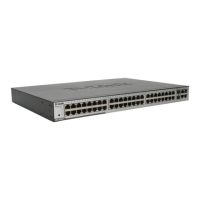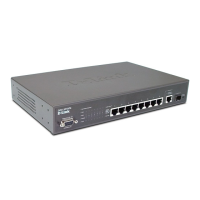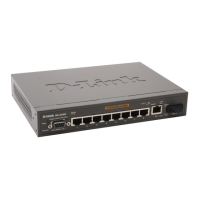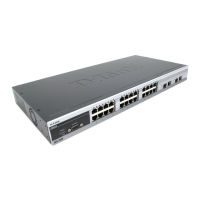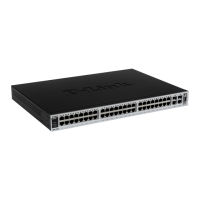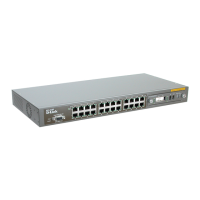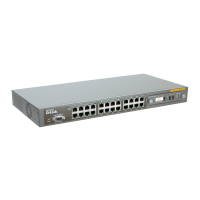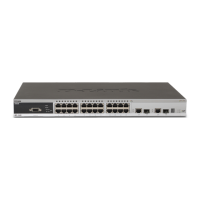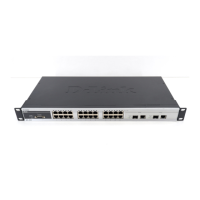Do you have a question about the D-Link DES-3052 and is the answer not in the manual?
Overview of the D-Link DES-3028/28P/52/52P switch series and its capabilities.
Highlights the main technical features and standards supported by the switch models.
Details the types of ports available on the switches and their compatibility.
Identifies and describes the components and LED indicators on the switch's front panel.
Provides instructions on how to install Small Form-Factor Pluggable (SFP) ports.
Lists the items included in the package and guidelines for preparing the installation site.
Details procedures for installing the switch on a desktop or in a rack.
Explains how to connect and power on the switch after installation.
Describes how to connect PCs, routers, and other end nodes to the switch ports.
Explains how to connect the switch to hubs, other switches, or uplinks.
Introduces the different methods available for managing the switch.
Details how to connect and configure the switch using the console port.
Guides users on how to access the switch's web-based management interface.
Explains the layout and functionality of the web-based user interface.
Displays essential device information and allows configuration of system parameters.
Details how to configure the switch's IP address, subnet mask, and default gateway.
Covers settings for port speed, duplex, flow control, and error handling.
Explains how to enable and configure DHCP/BOOTP relay functionalities.
Covers creating, modifying, and managing user accounts for switch access.
Details SNMP settings, including versions, traps, users, views, groups, and hosts.
Covers the configuration of Power over Ethernet (PoE) features and port settings.
Explains the concept and configuration of D-Link's Single IP Management.
Covers system log settings, SNTP, MAC notification, TFTP, Ping Test, and Safeguard Engine.
Details Virtual LANs (VLANs), including 802.1Q, static VLANs, and GVRP.
Explains port trunking and Link Aggregation Control Protocol (LACP) for increased bandwidth.
Covers the configuration of IGMP Snooping to manage multicast traffic.
Describes STP, RSTP, MSTP, and their configuration for network stability.
Explains the IEEE 802.1p standard for priority queuing and Quality of Service (CoS).
Covers CoS output scheduling, priority settings, TOS, DSCP, and MAC priority.
Details how to map port-based priority to CoS queues for traffic management.
Allows defining time periods during which Access Profiles will be active.
Covers creating rules based on Ethernet, IP, or Packet Content Mask.
Enables filtering of packets destined for the switch's CPU interface.
Manages traffic flow and prevents network storms like broadcast or multicast.
Secures ports by controlling MAC address learning and locking.
Details Secure Sockets Layer (SSL) and Secure Shell (SSH) configuration.
Implements port-based and MAC-based network access control using EAPOL.
Allows limited network access for non-802.1x supported devices.
Configures authentication policies using TACACS, RADIUS, and local user accounts.
Limits traffic flow between ports by segmenting traffic.
Monitors CPU and port utilization levels, displaying real-time graphs.
Provides detailed analysis of received and transmitted packets, errors, and size.
Allows viewing the MAC address table, switch logs, and IGMP snooping groups.
Monitors 802.1x statistics, RADIUS, Auth Diagnostics, Session Statistics, and Auth State.
Lists supported protocols, fiber-optic transceivers, and standards.
Details operating temperature, humidity, dimensions, weight, and EMI/Safety compliance.
Describes forwarding rates, switching capacity, buffer memory, and port features.
Details Power over Ethernet (PoE) capabilities and specifications.
Lists and explains various system log entries and their severity.
Provides a table of maximum cable lengths for different standards and media types.
Defines terms and acronyms used throughout the manual.
Outlines the warranty terms for hardware and software components.
Details the procedure for submitting warranty claims and obtaining service.
Specifies what is not covered by the limited warranty and disclaims other warranties.
| Type | Managed |
|---|---|
| Layer | Layer 2 |
| Operating Humidity | 10% to 90% non-condensing |
| Certifications | CE, FCC, RoHS |
| MAC Address Table Size | 8K |
| Power Supply | AC 100-240V, 50/60Hz |
| VLAN Support | Yes |
| Management | Web-based, SNMP |
| Jumbo Frame Support | Yes, up to 9K bytes |
| Power Consumption | 40W |
| Operating Temperature | 0°C to 40°C |
| Storage Temperature | -40°C to 70°C |

